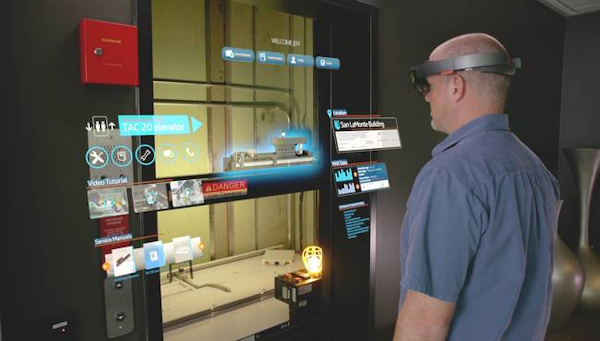[As the author of this piece in TreeHugger notes, mixed reality (and the presence experiences it provides) has great potential beyond the important application area of elevator maintenance and repair described here. The original story includes two videos and several more images; the press release is available from thyssenkrupp. –Matthew]

[Image: © thyssenkrupp/ using hololens to look at elevator]
It’s starting with elevators, but 3D tech like the Hololens will change the way we look at buildings
Lloyd Alter
September 16, 2016
This site has long been preoccupied with the future of work: how new technology is changing our jobs, and can possibly change our ecological footprint. I saw a bit of that future in New York City, with the demonstration of the use of Microsoft’s Hololens by thyssenkrupp Elevator.
The Hololens is described by Microsoft as “the first fully self-contained, holographic computer, enabling you to interact with high‑definition holograms in your world.” It’s not virtual reality, but what they call “Mixed reality”, which blends 3D holographic content into your physical world, “giving your holograms real-world context and scale, allowing you to interact with both digital content and the world around you.” You can see it in action in this video:
Essentially, you look through the goggles and see the object, can walk around it, zoom in and out, rotate and if it was built to do so, explode it into its components. As an architect, I can say right now that this is going to revolutionize the design, construction and maintenance of buildings, perhaps as dramatically as CAD and BIM have.
I believe this because elevators are a big, complex and expensive part of buildings, and thyssenkrupp Elevator is revolutionizing the way they work on them right now. However the technologies that they are demonstrating have broad implications for everyone in the building and many other businesses.
Elevators carry a billion people a day around the world, and are complex mixes of thousands of mechanical and electronic components. When they break down it’s a big deal, whether you are waiting for it or stuck in it. Lives depend on it. Maintenance is critical, both scheduled and emergency; thyssenkrupp alone has 24,000 technicians running around in trucks doing service. Given the different brands of elevators and the 150 years they have been in buildings, there must be millions of different configurations and parts. No wonder it always seems that it takes forever to fix them.
thyssenkrupp had already stepped into what felt like the science fiction realm with its MAX predictive maintenance system, covered in TreeHugger here. It connected elevators to Microsoft’s Azure IoT, turning elevators into a massive hub of sensors that fed enough information from enough connected elevators that they could start to really figure out what components needed maintenance when. Sam George, Partner Director, Microsoft Azure IoT, noted that “Predictive maintenance, powered by Microsoft Azure IoT, enabled thyssenkrupp to offer time savings to worldwide elevator passengers equivalent to 95 million hours of new availability per year of operation.”
Back in the day when I was in architecture and development, you dreaded the elevator maintenance visits. Residents would complain, it seemed always to take forever, hours or days might be lost while they ordered and waited for parts.
But when you put on the Hololens, you can walk around the elevator machine room before you get there and learn how it’s put together. You can zoom in and out, explode it so that you can see how the parts go together, figure out what is going on before you even get to the site.
If you are on site, you can look at components and describe the problems to an expert back at home office to get a second opinion. You can order parts by looking at them, seeing them pop up and just hit a virtual button. You are looking through these goggles; they are not like a virtual reality headset that replaces what you see. Instead you see the virtual and the reality together as it augments the view. As they note in the press release:
“Using HoloLens, service technicians will be able to visualize and identify problems with elevators ahead of a job, and have remote, hands-free access to technical and expert information when on site – all resulting in significant savings in time and stress. Initial field trials have already shown that a service maintenance intervention can be done up to four times faster than before by using the device.”
And possibly a lot fewer technician’s trucks on the road. CEO Andreas notes that it will change the way his employees work, introducing…
“….processes and training to enable technicians to do a better job with less stress and more fun. Our goal is to dramatically increase efficiency, raise elevator uptimes and speed up service interventions to ensure mobility equipment is always running as it should, providing each passenger with the safest and most comfortable travel experience possible.”
Elevators, with their importance, cost, complexity and legally mandated maintenance programs, are particularly well suited to this technology. But one can imagine entire buildings put together like this, where you can walk through the halls and see into walls, see where every valve and every switch is. It’s not just elevator technicians whose jobs are going virtual; this technology will affect every building professional and every trade.
I always worry when I go on these press trips and get in the bubble that I am going to lose perspective and perhaps gush too much. But this is seriously impressive technology, being put to work by a company that has taken a big staid industry and made it very exciting. So forgive the gush.
—
Lloyd Alter attended the press conference as a guest of ThyssenKrupp, which paid for his transportation and accommodation.